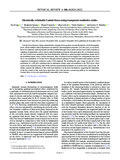Mostrar el registro sencillo del ítem
Electrically switchable Casimir forces using transparent conductive oxides
| dc.creator | Gong, Tao | es_ES |
| dc.creator | Spreng, Benjamin | es_ES |
| dc.creator | Camacho, Miguel | es_ES |
| dc.creator | Liberal Olleta, Íñigo | es_ES |
| dc.creator | Engheta, Nader | es_ES |
| dc.creator | Munday, Jeremy N. | es_ES |
| dc.date.accessioned | 2023-05-08T10:12:31Z | |
| dc.date.available | 2023-05-08T10:12:31Z | |
| dc.date.issued | 2022 | |
| dc.identifier.citation | Gong, T., Spreng, B., Camacho, M., Liberal, I., Engheta, N., & Munday, J. N. (2022). Electrically switchable Casimir forces using transparent conductive oxides. Physical Review A, 106(6), 062824. https://doi.org/10.1103/PhysRevA.106.062824 | en |
| dc.identifier.issn | 2469-9926 | |
| dc.identifier.uri | https://hdl.handle.net/2454/45251 | |
| dc.description.abstract | Casimir forces between charge-neutral bodies originate from quantum vacuum fluctuations of electromagnetic fields, which exhibit a critical dependence on material's electromagnetic properties. Over the years, in situ modulation of a material's optical properties has been enabled through various means and has been widely exploited in a plethora of applications such as electro-optical modulation, transient color generation, bio- or chemical sensing, etc. Yet Casimir force modulation has been hindered by difficulty in achieving high modulation signals due to the broadband nature of the Casimir interaction. Here we propose and investigate two configurations that allow for in situ modulation of Casimir forces through electrical gating of a metal-insulator-semiconductor junction comprised of transparent conductive oxide (TCO) materials. By switching the gate voltage on and off, a force modulation of >400 pN is predicted due to substantive charge carrier accumulation in the TCO layer, which can be easily measured using state-of-the-art force measurement techniques in an atomic force microscope. We further examine the influence of the oxide layer thickness on the force modulation, suggesting the importance of the fine control of the oxide layer deposition. Our work provides a promising pathway for modulating the Casimir effect in situ with experimentally measurable force contrast. | en |
| dc.description.sponsorship | The authors acknowledge financial support from the Defense Advanced Research Projects Agency (DARPA) QUEST program, Grant No. HR00112090084. | en |
| dc.format.mimetype | application/pdf | en |
| dc.language.iso | eng | en |
| dc.publisher | American Physical Society | en |
| dc.relation.ispartof | Physical Review A 106, 062824 (2022) | en |
| dc.rights | © 2022 American Physical Society. | en |
| dc.subject | Casimir forces | en |
| dc.subject | In situ modulation | en |
| dc.subject | Transparent conductive oxides | en |
| dc.title | Electrically switchable Casimir forces using transparent conductive oxides | en |
| dc.type | Artículo / Artikulua | es |
| dc.type | info:eu-repo/semantics/article | en |
| dc.date.updated | 2023-05-08T10:02:28Z | |
| dc.contributor.department | Institute of Smart Cities - ISC | en |
| dc.rights.accessRights | Acceso abierto / Sarbide irekia | es |
| dc.rights.accessRights | info:eu-repo/semantics/openAccess | en |
| dc.identifier.doi | 10.1103/PhysRevA.106.062824 | |
| dc.relation.publisherversion | https://doi.org/10.1103/PhysRevA.106.062824 | |
| dc.type.version | Versión publicada / Argitaratu den bertsioa | es |
| dc.type.version | info:eu-repo/semantics/publishedVersion | en |


